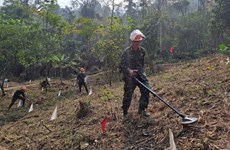‘Smoking gun' evades Delta officials
While cross-border smuggling in the Cuu Long ( Mekong ) Delta's
border areas has decreased somewhat, no headway has been made against
the trafficking of cigarette, local authorities concede.
While cross-border smuggling in the Cuu Long ( Mekong ) Delta's
border areas has decreased somewhat, no headway has been made against
the trafficking of cigarette, local authorities concede.
They say that the highly porous borders, lack of co-ordination between concerned agencies, lax local management as well as increasingly sophisticated and risky ruses employed by smugglers make containment extremely difficult.
The three hotspots for the smuggling in the region are the provinces of An Giang, Dong Thap and Kien Giang, all of which border Cambodia . In the lead up to the Tet (Lunar New Year) festival, the inflow of smuggled cigarettes from this area to HCM City has increased significantly.
The three Mekong Delta provinces account for 80 per cent of the total smuggled cigarettes consumed in the HCM City and the Delta markets.
Cigarettes are among the consumer goods that attract high taxes including alcohol and beer. Since the management policies on cigarette smuggling are tight and the product scarce, smugglers who can buy them cheap and sell at high prices stand to make substantial profits.
After the Government's Decree 76/ND-CP on cigarette production and trade issued last October came into force, there was a lull in the cigarette smuggling market, a trader in Long An, another Delta province that borders Cambodia, told the Lao Dong (Labour) newspaper on condition of anonymity.
"But it lasted for only few days and then came back to normal," he added.
He said Jet and Hero were the brands smuggled most into Viet Nam .
As cross-border smuggling typically surges ahead of Tet, Prime Minister Nguyen Tan Dung on Monday ordered a crackdown on the illegal activity.
He asked the Central Steering Committee 127 to work closely with provincial authorities to exert better control over cross-border smuggling by identifying routes and methods most used by smugglers.
Tough task
However, the fight against cigarette smuggling faced tough challenges, said Tran Minh Tien, deputy head of the Kien Giang Customs Department.
He said the smugglers had become more daring and were deploying more sophisticated tricks.
The most common method of smuggling cigarette was to transport them after splitting the cargo into smaller amounts, mostly by motorbikes that travel at high speed. The drivers always chose to go into heavy traffic during peak hours, making it very difficult for the police and customs officers to chase and catch them.
According to the Vietnam Tobacco Association, only one per cent, or 7.3 million packs, of the total cigarettes smuggled into Vietnam was seized last year. Around 800 million packs were smuggled into Vietnam last year through the southern region's western border, equivalent to 20 percent of the nation's total consumption.
Last year saw Kien Giang customs and police crack 38 smuggling cases and seize property worth more than 300 million VND (15,300 USD), including a small number of cigarette cases. This was 24 percent lower than the previous year. In the first 11 months of last year, anti-smuggling forces in Long An managed to seize only around 900,000 packs of cigarette.
The failure in controlling cigarette smuggling in this area in particular showed poor management, Tien said. The demarcation of responsibilities and jurisdiction over different markets and areas was partly responsible for this, he added./.
They say that the highly porous borders, lack of co-ordination between concerned agencies, lax local management as well as increasingly sophisticated and risky ruses employed by smugglers make containment extremely difficult.
The three hotspots for the smuggling in the region are the provinces of An Giang, Dong Thap and Kien Giang, all of which border Cambodia . In the lead up to the Tet (Lunar New Year) festival, the inflow of smuggled cigarettes from this area to HCM City has increased significantly.
The three Mekong Delta provinces account for 80 per cent of the total smuggled cigarettes consumed in the HCM City and the Delta markets.
Cigarettes are among the consumer goods that attract high taxes including alcohol and beer. Since the management policies on cigarette smuggling are tight and the product scarce, smugglers who can buy them cheap and sell at high prices stand to make substantial profits.
After the Government's Decree 76/ND-CP on cigarette production and trade issued last October came into force, there was a lull in the cigarette smuggling market, a trader in Long An, another Delta province that borders Cambodia, told the Lao Dong (Labour) newspaper on condition of anonymity.
"But it lasted for only few days and then came back to normal," he added.
He said Jet and Hero were the brands smuggled most into Viet Nam .
As cross-border smuggling typically surges ahead of Tet, Prime Minister Nguyen Tan Dung on Monday ordered a crackdown on the illegal activity.
He asked the Central Steering Committee 127 to work closely with provincial authorities to exert better control over cross-border smuggling by identifying routes and methods most used by smugglers.
Tough task
However, the fight against cigarette smuggling faced tough challenges, said Tran Minh Tien, deputy head of the Kien Giang Customs Department.
He said the smugglers had become more daring and were deploying more sophisticated tricks.
The most common method of smuggling cigarette was to transport them after splitting the cargo into smaller amounts, mostly by motorbikes that travel at high speed. The drivers always chose to go into heavy traffic during peak hours, making it very difficult for the police and customs officers to chase and catch them.
According to the Vietnam Tobacco Association, only one per cent, or 7.3 million packs, of the total cigarettes smuggled into Vietnam was seized last year. Around 800 million packs were smuggled into Vietnam last year through the southern region's western border, equivalent to 20 percent of the nation's total consumption.
Last year saw Kien Giang customs and police crack 38 smuggling cases and seize property worth more than 300 million VND (15,300 USD), including a small number of cigarette cases. This was 24 percent lower than the previous year. In the first 11 months of last year, anti-smuggling forces in Long An managed to seize only around 900,000 packs of cigarette.
The failure in controlling cigarette smuggling in this area in particular showed poor management, Tien said. The demarcation of responsibilities and jurisdiction over different markets and areas was partly responsible for this, he added./.












